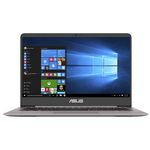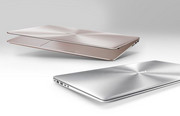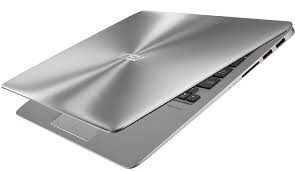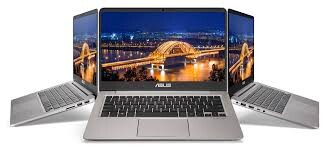Asus UX410UQ-GV034T
Specifications

Price comparison
Average of 2 scores (from 4 reviews)
Reviews for the Asus UX410UQ-GV034T
Source: Laptop Media
 Archive.org version
Archive.org versionObviously, this ultrabook isn’t meant for gaming but it excels in almost everything rather than cooling performance. The ZenBook UX410UQ surprises with excellent CPU and GPU performance, portability, build quality and display. Especially at this price range, the ZenBook UX410UQ has little competition and it’s, hands down, one of the best 14-inch laptops in this ballpark.
Single Review, online available, Very Long, Date: 07/25/2017
Source: Ultrabook Review
 Archive.org version
Archive.org versionThe Zenbook UX410 is one these modern ultraportables that squeeze a bigger screen inside a compact shell. In this case, it's an excellent 14-inch matte display inside the body of a 13-inch notebook. It's not as light or as thin as some other ultraportables out there, but it gets you a Core i7 processor and Nvidia graphics that perform flawlessly and keep cool even under load, lasts for a long time on a charge, offers good IO and upgradeable hardware. There are however a few nits and bits that spoil what could have otherwise been an excellent multimedia laptop, but you'll find more about these from the article below.
Single Review, online available, Long, Date: 07/24/2017
Rating: Total score: 80%
Foreign Reviews
Source: PC Lab.pl
 PL→EN Archive.org version
PL→EN Archive.org versionSingle Review, online available, Very Long, Date: 03/08/2017
Rating: Total score: 60%
Source: Zing
 VN→EN Archive.org version
VN→EN Archive.org versionPositive: Compact size; powerful processor; excellent display; beautiful design.
Single Review, online available, Long, Date: 03/21/2017
Comment
Model:
As ultrabooks begin to take the place of normal-sized notebooks, there will come a point where manufacturers may have to squeeze in a little more than just processing power to satisfy the needs of their consumers. One example is the Asus UX410UQ-GV034T, which not only maintains its ultrabook status, but also has the graphical horsepower to boot. One of its notable features is its excellent 14-inch display that was somehow squeezed into a 13-inch frame. While this may not make sense both physically and mentally, it works only because displays are measured diagonally and not horizontally like the chassis measurement. While the Asus UX410UQ-GV034T is classified as an ultrabook, it is actually slightly thicker than the average ultrabook. Nonetheless, it still qualifies for the moniker. Starting with the basics of the specifications, the Asus UX410UQ-GV034T is powered by an Intel Core i7-7500U with 8GB of memory, 512GB of solid state storage and, lastly, the pièce de résistance of this device, the included Nvidia Geforce 940MX. Users may wonder: With an actual dedicated graphics chip, will the ultrabook not suffer from throttling issues? It is safe to say that will not be the case. Despite having a high-end CPU and a mid-end GPU, the ultrabook was able to stay cool even under load.
Naturally, as this is a Zenbook, users can look forward to having a premium chassis made of aluminum, which most manufacturers tend to use. Nevertheless, it should be noted that the chassis does not have a unibody design, which means there might be a little flex, although it is not noticeable. Overall, the ultrabook remains as solid and reliable as can be. As this is considered a premium device, users can also choose from 2 colours, namely Rose Gold and Quartz Gray. Colour choices aside, the UX410UQ maintains a low profile with plenty of space for the palm rest. Next on the checklist would be the UX410UQ’s IO which has its plus and minus sides. On the one hand, because it is slightly thicker than most ultrabooks out there, Asus was able to squeeze in 3 standard full-sized USB ports, 1 USB Type-C Gen-1 port, an HDMI port, a card-reader and an audio jack, although it should be mentioned that most of the ports are placed on the right, which means the left side is mostly empty. This can lead to a slightly overcrowded IO if all of them are used at once.
Moving forward to the input devices, the keyboard may look familiar when compared to other Zenbook models. In terms of key travel, the UX410UQ feels a little deep with some spongy feedback which can leave users doubting whether their key press was registered. Naturally, not everyone types the same, so the topic of keyboards can be a little subjective. It should be noted as well that the keyboard is backlit, which will help users type in low light settings. Overall, the keyboard is reasonably quiet. Moving over to the trackpad, it seems as if the integrated touch/clickpad is more of a hit-or-miss case. While precision and tracking is relatively good, the clickpad does suffer from some cursor jumping issues, which is a software issue that has been consistent on older Asus models. As for the actual clicking, depending on the user, some may prefer an actual click button instead of the integrated ones, as they can occasionally not register which click you are trying to perform. Taking a look at the display, the UX410UQ has a FHD IPS-based panel, which is just fine, especially for its tier. The display was able to score an sRGB rating of 100%, which is great, and 78% on AdobeRGB, which is not too shabby. This means content creators can still make use of the display without worrying too much about color accuracy.
In regards to the audio department, the equipped speakers are generally a mixed bag. This is probably due to the fact that the speakers are bottom-mounted, which leads to a slightly muffled audio. Some users may find this annoying, but quality wise, the audio is not really bad. With the included Audio Wizard app, users can try to compensate for the muffled audio, although in most cases, a pair of headphones would be recommended. Lastly, as this is an ultrabook, the battery life should be mentioned. In terms of battery size, it is sadly small for an ultrabook of this size. However, it can also be considered standard for its class. Overall, the UX410UQ scored 4 hours and 5 minutes on Wi-Fi and 1 hour and 25 minutes when gaming on the go, which is expected. In the end, when it comes to deciding, users should consider what they really need from an ultrabook. If it is all about the runtimes, you should look away, but if you are the kind of user who wants a light and well-performing package, this might be a good middle ground for both.
Hands-on article by Jagadisa Rajarathnam
NVIDIA GeForce 940MX: Mid-range laptop graphics card based on the Maxwell architecture. Compared to the older 940M, the MX now also supports GDDR5 graphics memory and maybe slightly faster clock speeds.
Modern games should be playable with these graphics cards at low settings and resolutions. Casual gamers may be happy with these cards.
» Further information can be found in our Comparison of Mobile Graphics Cards and the corresponding Benchmark List.
i7-7500U: Kaby-Lake based SoC with two CPU cores clocked at 2.7 to 3.5 GHz, HyperThreading and manufactured with an improved 14nm process.» Further information can be found in our Comparison of Mobile Processsors.




